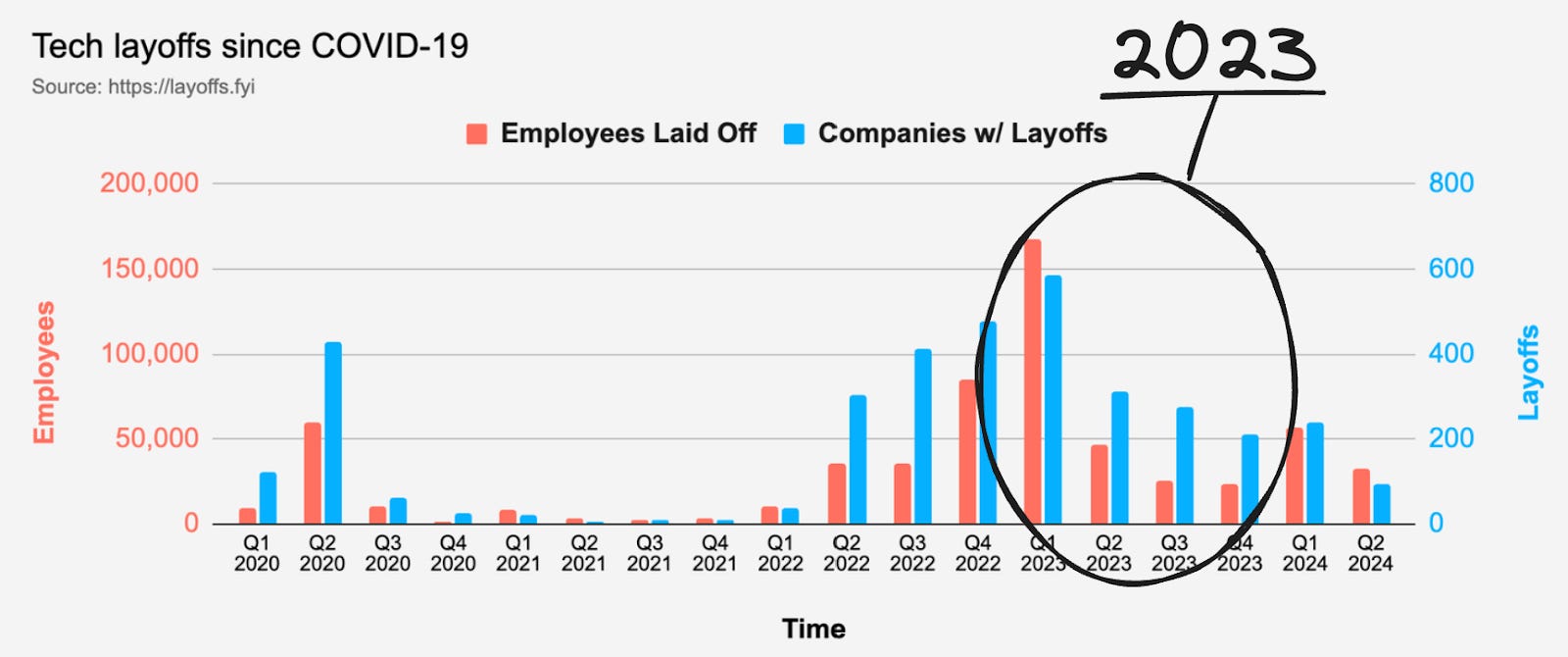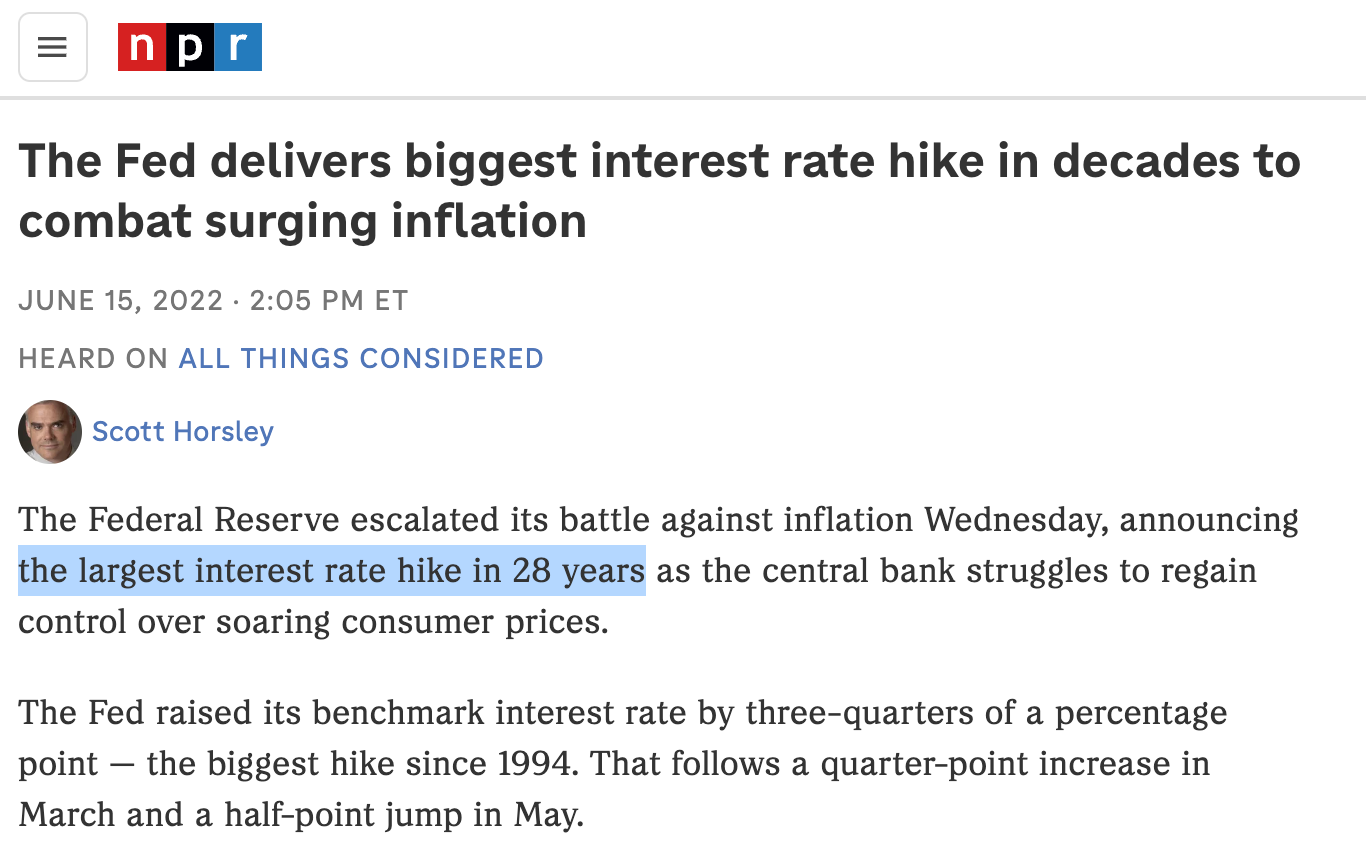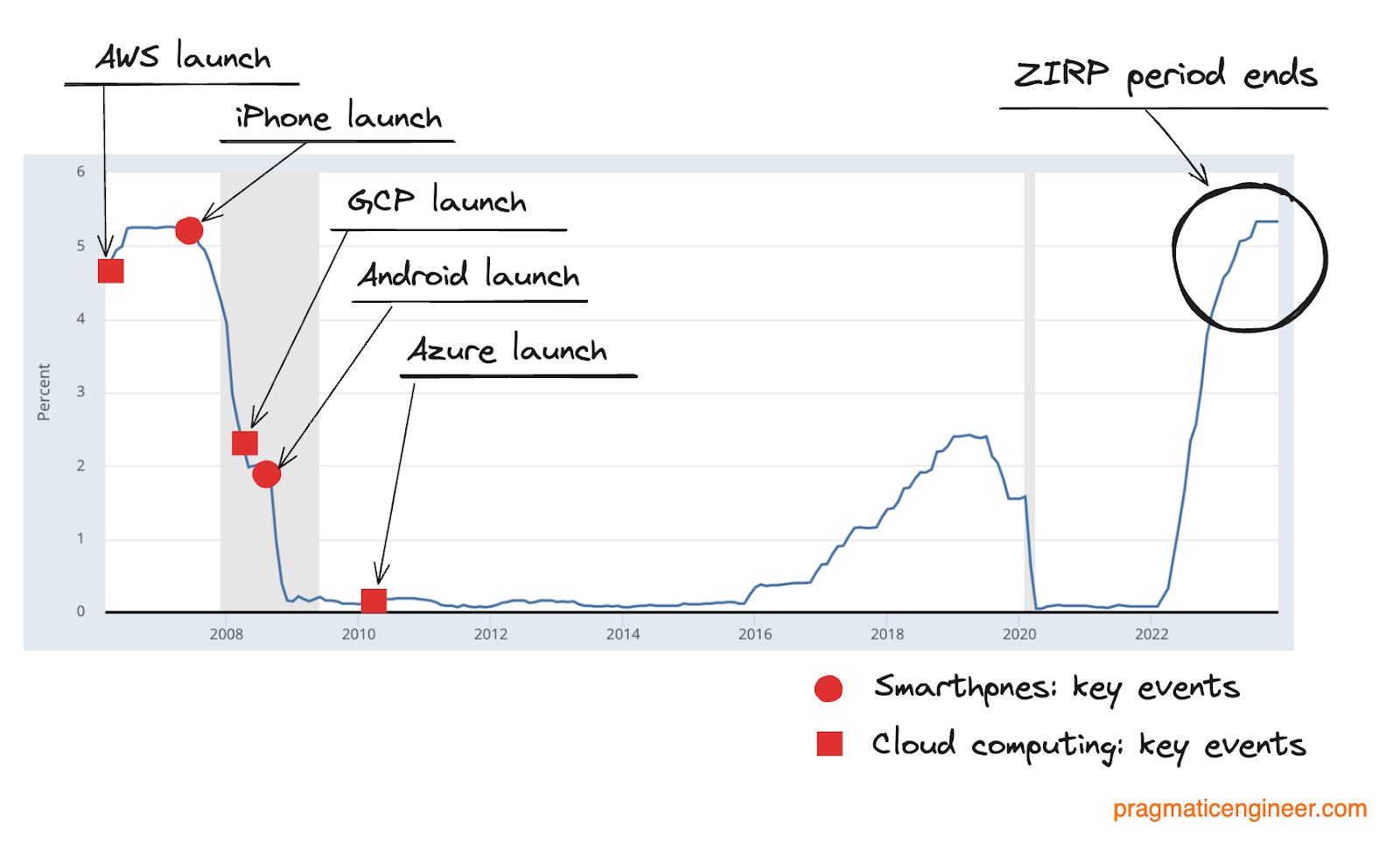👋 Hi, this is Gergely with a free issue of the Pragmatic Engineer Newsletter. In every issue, I cover challenges at Big Tech and startups through the lens of engineering managers and senior engineers. If you’ve been forwarded this email, you can subscribe here. What is Old is New AgainThe past 18 months have seen major change reshape the tech industry. What does this mean for businesses, dev teams, and what will pragmatic software engineering approaches look like, in the future?I tackled these burning questions in my conference talk, “What’s Old is New Again,” which was the keynote at Craft Conference in Budapest, Hungary, in May. If you were there, I hope you enjoyed it! This article contains the full presentation, slides, and summary. If you have some time to spare, you can check out the edited recording below, which has just been published. Shout out to the Craft Conference team for the excellent video production, and for organizing the event! In this article, we cover the first part of the talk, offer some pointers, analysis, and further reading:
The bottom of this article could be cut off in some email clients. Read the full article uninterrupted, online. 1. What’s going on?The tech jobs market, VC funding, IPOs, and Big Tech have been heavily affected by the winds of change in the past 2 years. Job marketThe end of 2021 was the hottest tech hiring market of all time, as described in The Pragmatic Engineer:
Analyzing the situation back then, I outlined six factors causing that “perfect storm” in the jobs market which turned it into an employee’s dream. Six months later in February 2022, the New York Times (NYT) ran an article coming to a similar conclusion that tech companies faced a hiring crisis. However, by the time the NYT noticed, the job market was already changing fast again… April and May 2022 saw unexpected layoffs:
Fall 2022 saw the big cuts continue, with Lyft, Stripe, CloudKitchens, Delivery Hero, OpenDoor, Chime, MessageBird, and others slashing 10% of their jobs or more. One thing connected many redundancies: they happened at loss-making companies, so were easier to justify than at businesses that were in the black. But then profitable companies started making cuts, too. In November 2022, Meta let go 11,000 people (13% of staff) in what were the first-ever layoffs at the social media giant. A few months later, Google, Microsoft, and Amazon followed suit; creating the biggest spike in job cuts to date.
VC fundingBefore 2020, VC investment in startups was rising steadily. Then in 2021, the pace of investment exploded; nearly doubling:
Since then, VC investment has steadily fallen. In Q1 of this year, it was at the same level as 2018! IPOs2021 was a standout year for public offerings, as a relative flood of tech companies floated on the stock market.
For a sense of just how many IPOs there were that year, here’s just a few of the notable ones: GitLab (version control,) Rivian (electric vehicles,) Couchbase (NoSQL database,) Affirm (buy-now-pay-later,) Bumble (dating,) Duolingo (language learning,) Robinhood (trading,) Expensify (expensing,) Nubank (fintech,) Roblox (gaming,) Coinbase (crypto,) Squarespace (domains,) Coupang (e-commerce,) DigitalOcean (hosting,) Toast (restaurant tech,) Coursera (edtech,) Udemy (edtech,) Amplitude (analytics,) AppLovin (mobile analytics,) UiPath (automation,) Monday.com (project management,) Confluent (data streaming,) Didi Chuxing (ridesharing,) Outbrain (advertising,) Nerdwallet (personal finance.) By comparison, there were precisely zero tech IPOs in 2022, and only three in 2023 (ARM, Instacart, and Klaviyo.) Little did we know at the time, but HashiCorp’s IPO in December 2021 was the last one for 18 months.
Big TechThe tech giants did large layoffs in early 2023, which were justified with the claim they’d overhired during the pandemic of 2020-2022. However, by the start of this year, Big Tech was still doing mass layoffs, despite not having overhired AND posting record profits. Google was the model case; founded in 1998, it had only done a single mass layoff back in 2008, when 2% of staff (300 people) were let go. Then in January 2023, around 6% of staff were let go. In January 2024, amid record revenue and profits, the search giant cut yet more staff: Google’s approach looks pretty typical; regardless of record income and profits, Big Tech companies seem to have become comfortable with regularly letting people go.
I analyzed the rationale behind these cuts at the time, writing:
Summing upHere are the changes we’re seeing: 2. Why is this happening today?Something changed around 2022-2023. But what? An obvious candidate was the end of the pandemic and lockdowns of 2020-2021, as the world slowly returned to normal. At the time, founders and CTOs told me why their companies were cutting staff, and why their businesses suddenly faced growth challenges. The “macroeconomic environment” was repeatedly mentioned and was echoed in company announcements reporting job cuts. It became clear that changing interest rates had a larger-than-expected role. In mid-2022, the US Federal Reserve (FED) did something not seen in decades by increasing interest rates dramatically:
What are interest rates, and why are they going up?We need to take a brief but necessary detour to understand interest rates a bit. I refer to “interest rates” as the rate set by national central banks. In the US, this is the Federal Reserve (the Fed,) in the UK it’s the Bank of England, and in the EU it’s the European Central Bank (ECB.) These institutions aim to maintain financial stability with a mandate to execute governmental fiscal policy, which may be to increase or decrease consumer spending, increase or decrease inflation, etc. One of the most powerful “levers” a central bank has at its disposal is to set the interest rates that apply to deposits and debts. In 2022, inflation was at a 40-year-high in the US (9.1% in July 2022), a 30-year-high in the UK (8.6% in August,) and at its highest-ever in the EU (9.2% in 2022.) Governments in these places set fiscal policies to try and pull inflation down to around 2-3%. The Fed, Bank of England, and (ECB) all took the same action: they raised interest rates. How do higher interest rates slow down the rate of inflation? Here’s an explainer from the BBC:
Replace “Bank of England,” with “Fed,” or “ECB,” and it’s the same. Raising rates is a tried-and-testing method for tackling inflation, worldwide. Why do higher rates matter?In the US, the interest rate jumped from almost 0% to around 5% in less than a year:
To understand whether this rate change was “business as usual,” let’s look back 15 years or so:
This graph is eye-opening. Dating back to 2009, the interest rate was close to 0%, and then between 2017-2019 it climbed to around 2%. Then it promptly went back to zero due to the pandemic, as the Fed tried to discourage saving and encourage spending in order to stimulate the economy and avert recession. Now let’s zoom out all way back to 1955 for a sense of what “normal” interest rates typically are, over time:
A “wow” point in the graph above reveals that ultra-low interest rates are historically atypical. Let’s mark up the periods when the interest rate was at or below 1%: Since 1955, there have been a total of 11.5 years of ultra-low “near-zero” interest rates, 11 of which occurred after 2009. That’s why it’s known as a zero interest rate period (ZIRP.) Interestingly, this ZIRP was not unique to the US. Very similar events played out in Canada, the UK, and the EU, due to the global financial crisis (GFC) of 2007-2008, when the financial system had a near-death experience.
3. Impact of interest rates on tech startupsIt’s tempting to assume tech is unconnected to finance and interest rates, but the truth is the opposite. This is not me saying it, but Bloomberg analyst and columnist Matt Levine, who’s passionate about the tech industry and explains how fiscal policies affect industry. In 2023, he analyzed the collapse of Silicon Valley Bank:
When I read this analysis, my instinct was to push back. Surely there could not be such a basic connection between interest rates and tech startups? However, the more I thought about it, the more I saw Levine had a solid point. Let’s analyze what happens when interest rates rapidly increase from 0% to 5%, as they did: Let’s also look at topics this newsletter covers, like VC funding, IPOs, Big Tech, and the job market, and how interest rates affect them:
Let’s compare these with the changes of the past two years, as described in section 1 of this article; ‘What is going on?’ Comparing what we logically should happen with rising interest rates, versus what we are currently seeing: It may be unexpected, but rising interest rates explain many trends in the tech market. 4. Smartphone and cloud revolutionsThe drop in interest rates from around 2009 drove more venture capital into startups because VC investing is more attractive when interest rates are at rock bottom and the returns from government bonds are low. Two other factors also began to make an impact at around the time of the GFC. Smartphone revolutionThe iPhone launched in 2007 and the now-defunct Windows Phone followed two years later. Smartphones have transformed consumer tech, and were the catalyst for mobile-first tech companies, like Spotify (founded 2006,) WhatsApp (2009,) Instagram (2010,) Uber (2010,) Snap (2011,) and thousands more. Cloud revolutionAt around the same time as smartphones appeared, the first cloud providers launched:
Cloud providers made it much faster and cheaper for startups to build products. Instead of having to buy and operate on-prem servers, they could just rent a virtual server. And if they needed more capacity, they could just pay for it and scale up almost immediately. Early Amazon employee, Joshua Burgin, (now VP of Engineering at VMWare) described it in The past and future of modern backend practices:
Some of the best-known AWS customers today are Netflix, Airbnb, Stripe, and Twitch. All grew faster – and likely needed less capital – by utilizing the cloud. OverlapThe smartphone and cloud revolutions coincided almost perfectly with when interest rates fell to zero and then stayed in the deep freeze for a decade: These developments gave VCs even more reason to invest in startups:
It’s likely the 2010s were a golden age for tech startups, due to the ahistorical combination of the longest-ever period of 0% interest rates, and two technological revolutions which kicked off at that time. Today, another potential tech revolution is heating up: generative AI, and large language models (LLM.) The AI revolution has similarities to the cloud revolution in how AI could also bring efficiency increases (once AI costs decrease from where are today.) However, the AI revolution is very different in nature to the smartphone revolution: this is because AI doesn’t appear to offer a new, initially free, broad distribution channel like the smartphone did for app makers. And the GenAI revolution also began in a high interest rate environment: We cover more on the “how” of GenAI in these articles: 5. New realitySo, what is the “new reality” which we work in? Check out this part of the presentation for my take on what it means for software engineers and engineering practices. Basically, it’s tougher for software engineers to land jobs, and career advancement is slower. For engineering practices, we’ll likely see a push to choose “boring” technology, monoliths become more popular, “fullstack” and Typescript gain more momentum, and more responsibilities “shift left” onto developers.
Previous newsletters go into even more depth: 6. History repeating?Change is often unfamiliar and unexpected. Those around for the Dotcom Bust of 2001 must see similarities between today and the sudden changes wrought when the tech bubble burst, back then. Software engineers who were working during that period offer perspectives and tactical advice on how to prioritize career security when job security feels beyond control. 7. Q&A, slides and further readingFor a recap of the Q&A following the talk, see this recording. Access the presentation slides. I’ve covered several topics from my talk at length in individual analysis pieces. For more, check out: TakeawaysSometimes it’s helpful to “zoom out” and take stock of change as it unfolds across tech, in order to understand more about it. The demise of 0% interest rates is a mega-event with notable effects on the tech industry. It’s hard to predict the future – especially in tech, where things change fast – but I find it useful to seek understanding of the underlying forces influencing the direction of the sector. From one perspective, the history of the tech industry is one of cyclical booms and busts. Innovation is fertile ground for new business opportunities, and I have no doubt there’s many boom times ahead; we just need to recognize them when they happen! After the keynote, several people shared with me that it had “clicked” with them, in terms of their experience at work, at their friends’ workplaces, and on the job market. One participant said they’re planning their next career step, and understanding the trends at work is helping them to make more considered decisions:
I hope you found this analysis insightful, and the talk interesting to watch! Finally, a big thank you to Craft Conference for hosting me. I asked the organizers how the conference did this year, and here are interesting statistics they shared with me:
The event is annual and the next edition will take place in spring 2025. You’re on the free list for The Pragmatic Engineer. For the full experience, become a paying subscriber. Many readers expense this newsletter within their company’s training/learning/development budget. This post is public, so feel free to share and forward it. If you enjoyed this post, you might enjoy my book, The Software Engineer's Guidebook. Here is what Tanya Reilly, senior principal engineer and author of The Staff Engineer's Path said about it:
|
Search thousands of free JavaScript snippets that you can quickly copy and paste into your web pages. Get free JavaScript tutorials, references, code, menus, calendars, popup windows, games, and much more.
What is Old is New Again
Subscribe to:
Post Comments (Atom)
Top 3 UX Design Articles of 2024 to Remember
Based on most subscriptions ͏ ͏ ͏ ͏ ͏ ͏ ͏ ͏ ͏ ͏ ͏ ͏ ͏ ͏ ͏ ͏ ...
-
code.gs // 1. Enter sheet name where data is to be written below var SHEET_NAME = "Sheet1" ; // 2. Run > setup // // 3....






















No comments:
Post a Comment